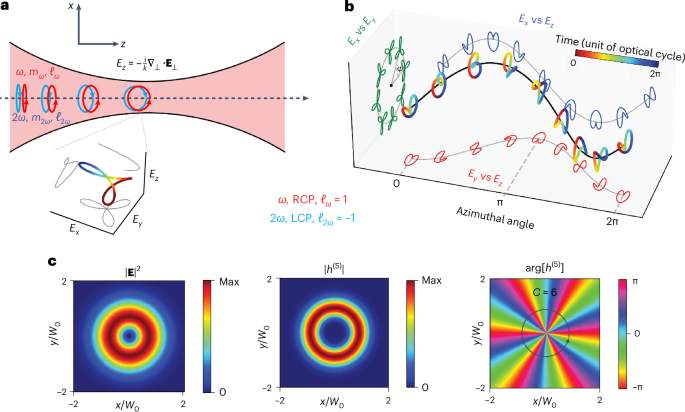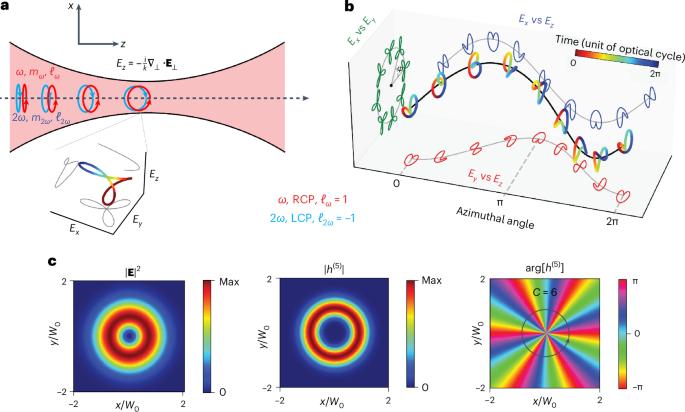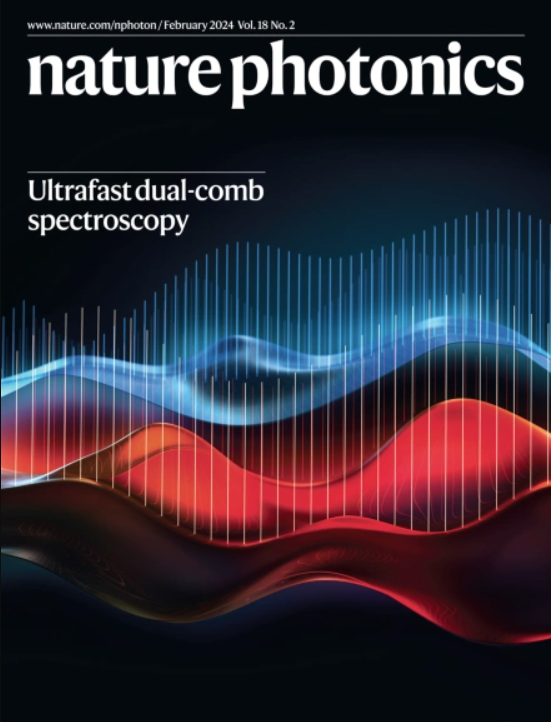Chiral topological light for detection of robust enantiosensitive observables
IF 32.3
1区 物理与天体物理
Q1 OPTICS
引用次数: 0
Abstract
The topological response of matter to electromagnetic fields is a highly demanded property in materials design and metrology due to its robustness against noise and decoherence, stimulating recent advances in ultrafast photonics. Embedding topological properties into the enantiosensitive optical response of chiral molecules could therefore enhance the efficiency and robustness of chiral optical discrimination. Here we achieve such a topological embedding by introducing the concept of chiral topological light—a light beam which displays chirality locally, with an azimuthal distribution of its handedness described globally by a topological charge. The topological charge is mapped onto the azimuthal intensity modulation of the non-linear optical response, where enantiosensitivity is encoded into its spatial rotation. The spatial rotation is robust against intensity fluctuations and imperfect local polarization states of the driving field. Our theoretical results show that chiral topological light enables detection of percentage-level enantiomeric excesses in randomly oriented mixtures of chiral molecules, opening a way to new, extremely sensitive and robust chiro-optical spectroscopies with attosecond time resolution. The concept of chiral topological light—a polychromatic light with chiral closed 3D polarization trajectories, space-varying with the azimuthal angle—is introduced and used for efficient sensing in chiral molecules, showcasing an example of successful application of topological concepts in optics.


用于检测稳健对映敏感观测值的手性拓扑光
物质对电磁场的拓扑响应因其抗噪声和退相干的特性而成为材料设计和计量学中的热门特性,并推动了超快光子学的最新进展。因此,在手性分子的对映敏感光学响应中嵌入拓扑特性可以提高手性光学辨别的效率和稳健性。在这里,我们通过引入手性拓扑光的概念来实现这种拓扑嵌入--手性拓扑光是一种局部显示手性的光束,其手性的方位角分布由拓扑电荷全局描述。拓扑电荷被映射到非线性光学响应的方位角强度调制上,对映敏感性被编码到其空间旋转中。空间旋转对驱动场的强度波动和不完美的局部偏振态具有稳健性。我们的理论结果表明,手性拓扑光能够检测随机取向的手性分子混合物中对映体过量的百分比水平,为具有阿秒级时间分辨率的新型、极其灵敏和稳健的螺旋光学光谱学开辟了道路。
本文章由计算机程序翻译,如有差异,请以英文原文为准。
求助全文
约1分钟内获得全文
求助全文
来源期刊

Nature Photonics
物理-光学
CiteScore
54.20
自引率
1.70%
发文量
158
审稿时长
12 months
期刊介绍:
Nature Photonics is a monthly journal dedicated to the scientific study and application of light, known as Photonics. It publishes top-quality, peer-reviewed research across all areas of light generation, manipulation, and detection.
The journal encompasses research into the fundamental properties of light and its interactions with matter, as well as the latest developments in optoelectronic devices and emerging photonics applications. Topics covered include lasers, LEDs, imaging, detectors, optoelectronic devices, quantum optics, biophotonics, optical data storage, spectroscopy, fiber optics, solar energy, displays, terahertz technology, nonlinear optics, plasmonics, nanophotonics, and X-rays.
In addition to research papers and review articles summarizing scientific findings in optoelectronics, Nature Photonics also features News and Views pieces and research highlights. It uniquely includes articles on the business aspects of the industry, such as technology commercialization and market analysis, offering a comprehensive perspective on the field.
 求助内容:
求助内容: 应助结果提醒方式:
应助结果提醒方式:


